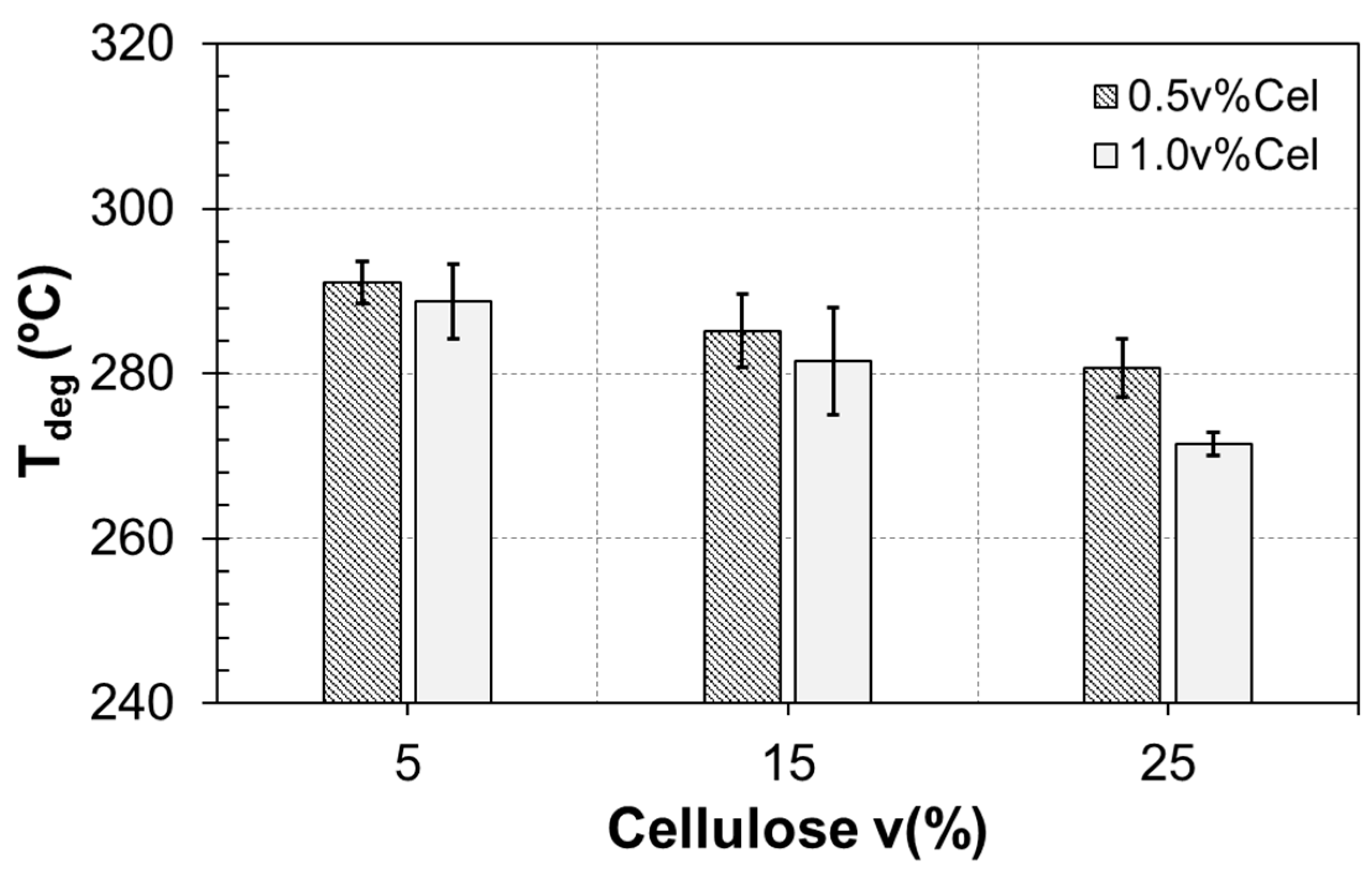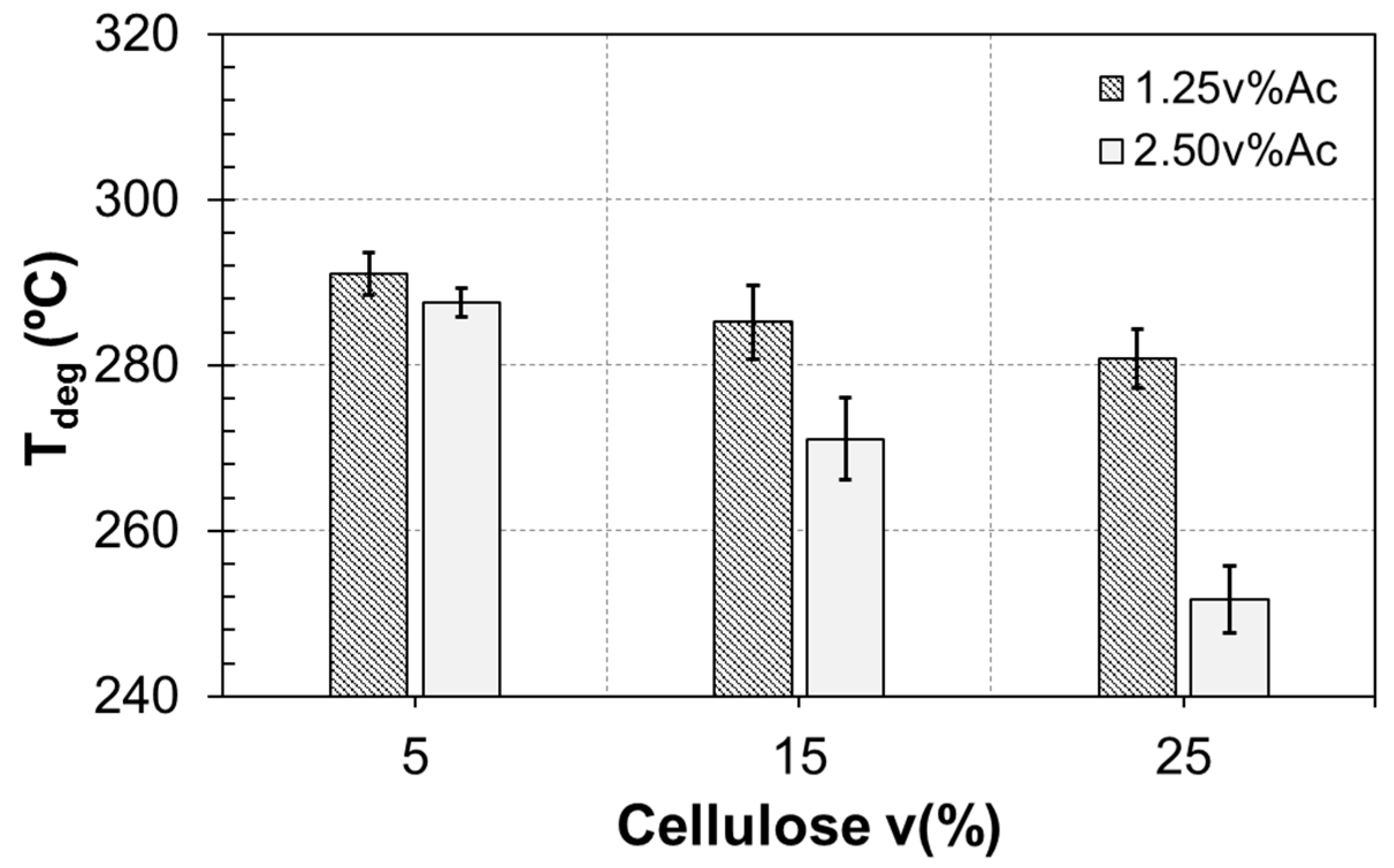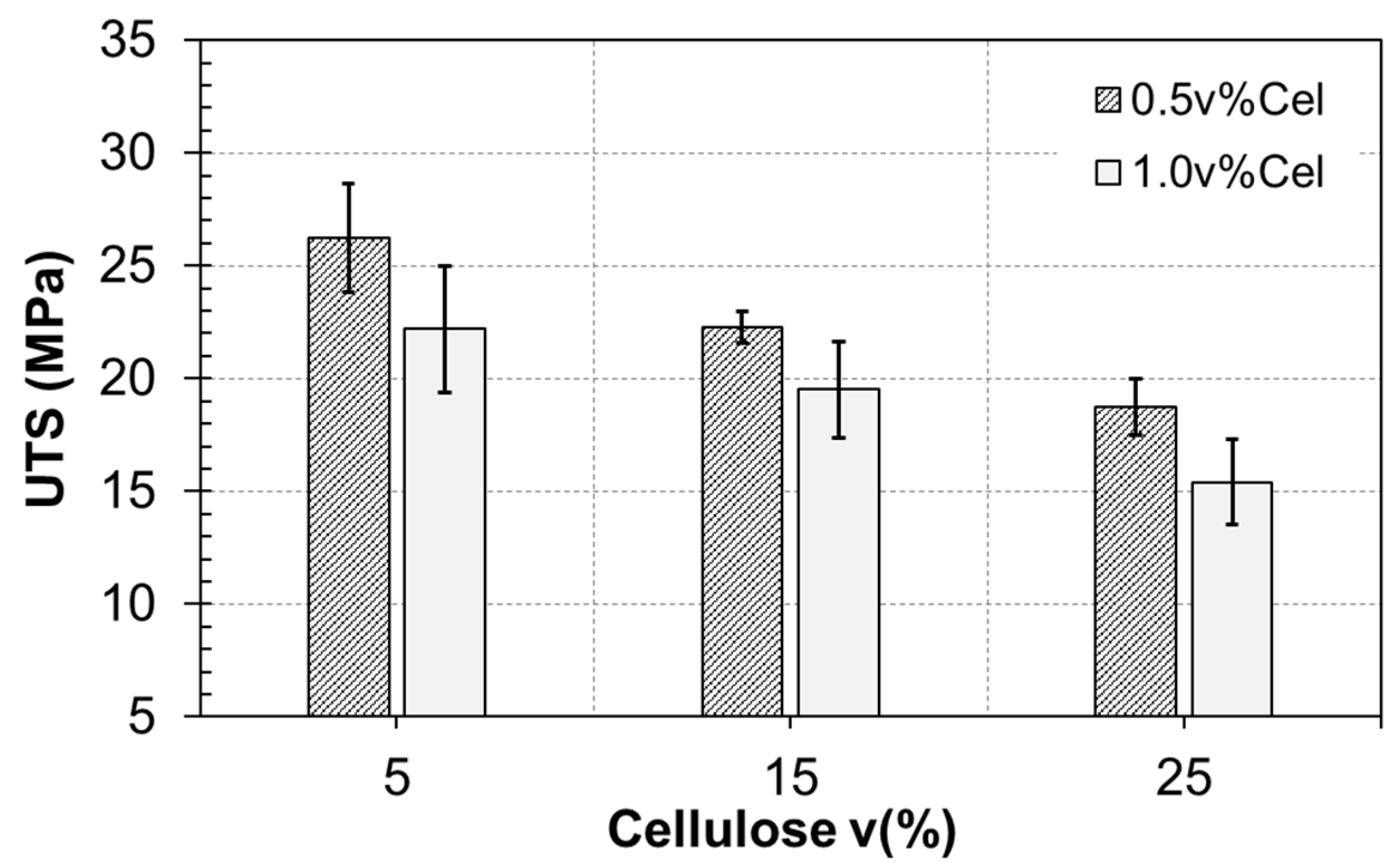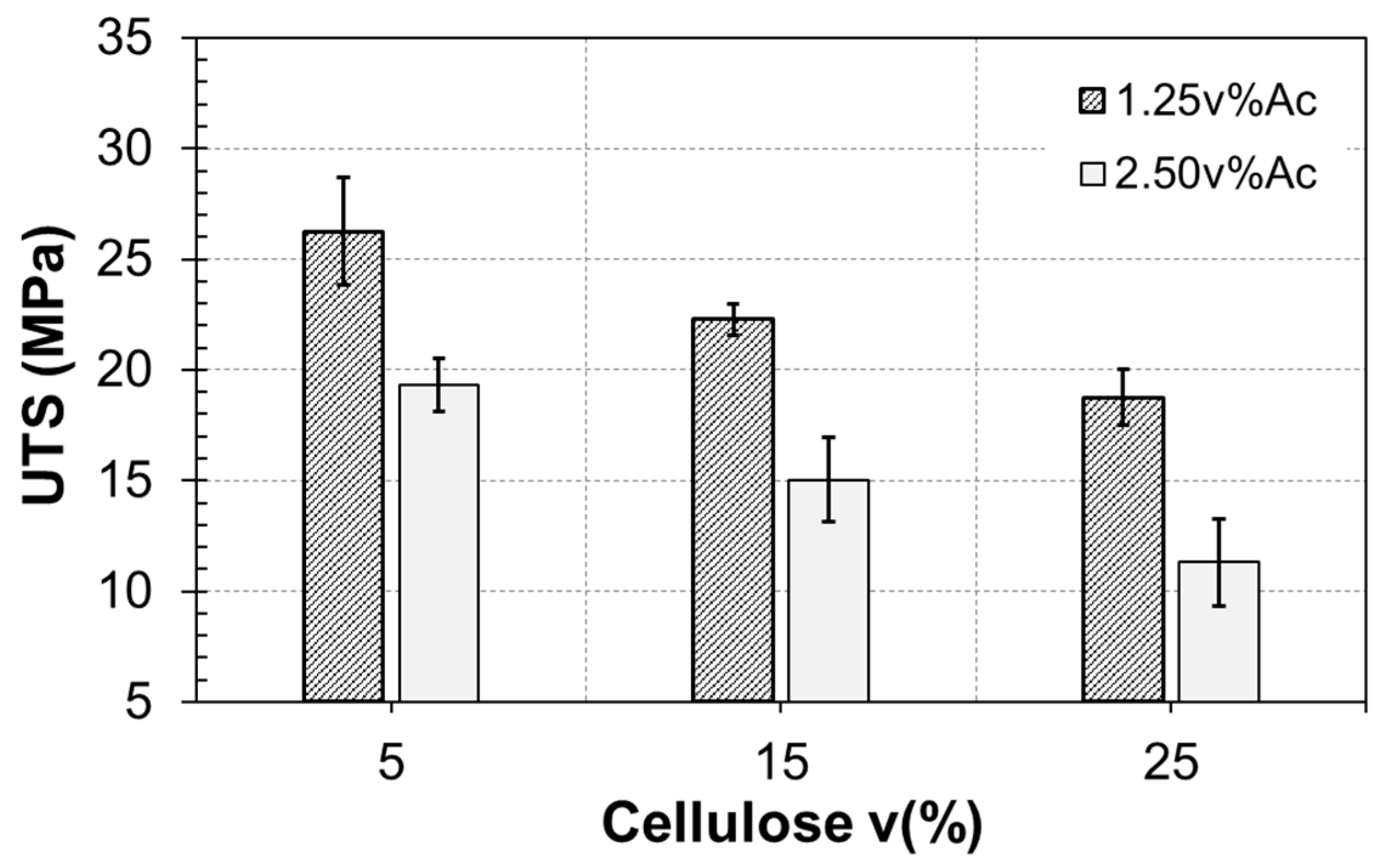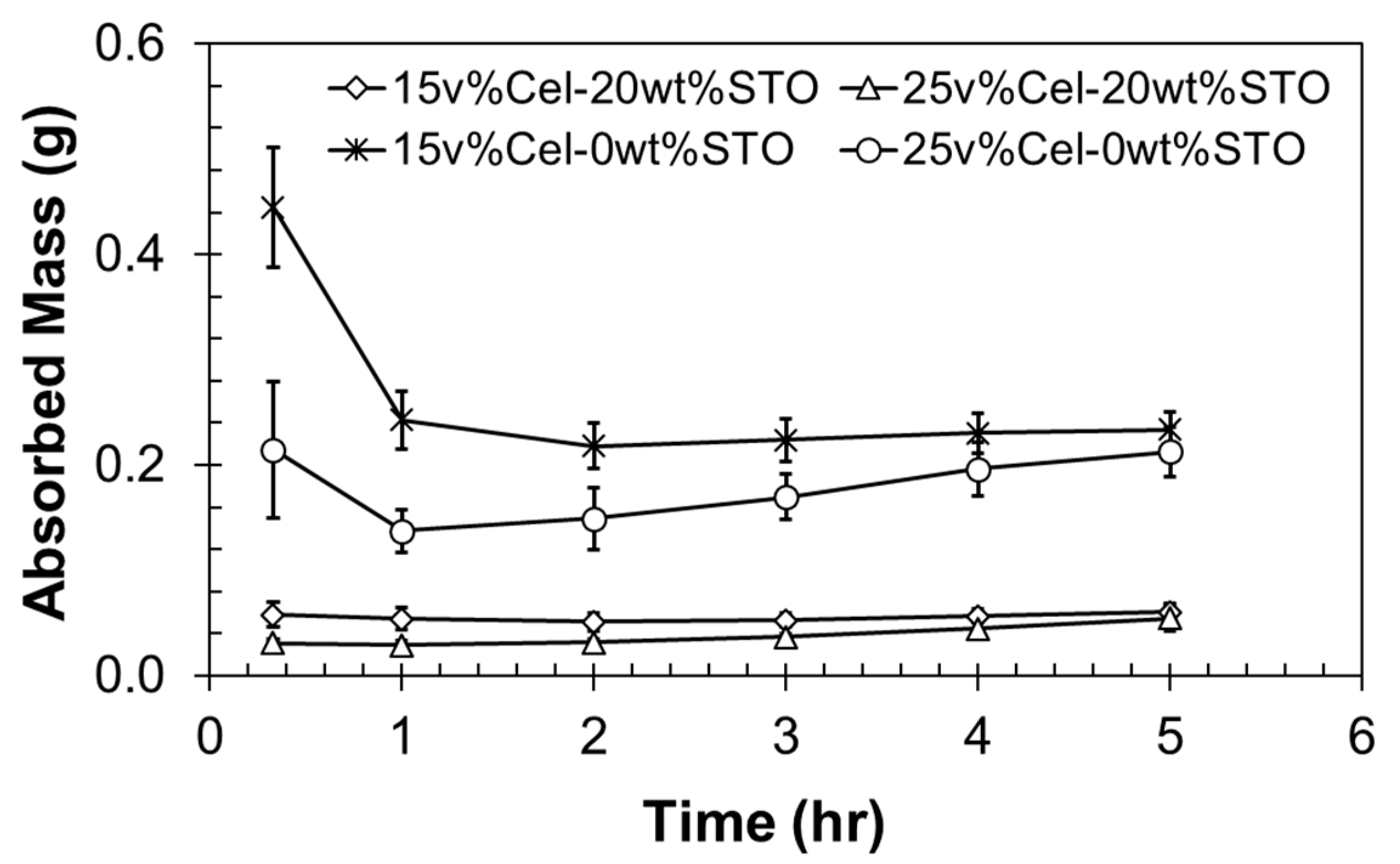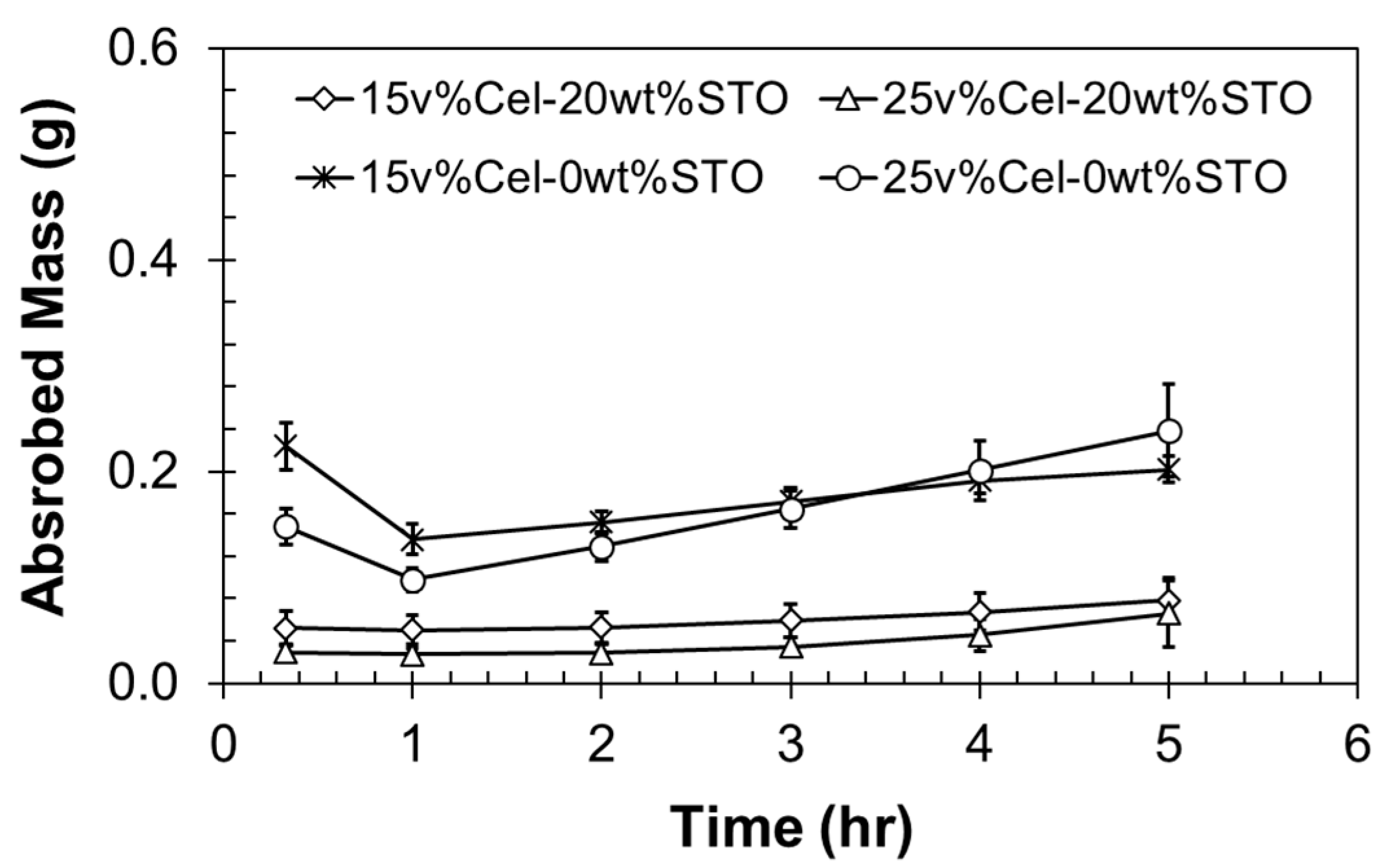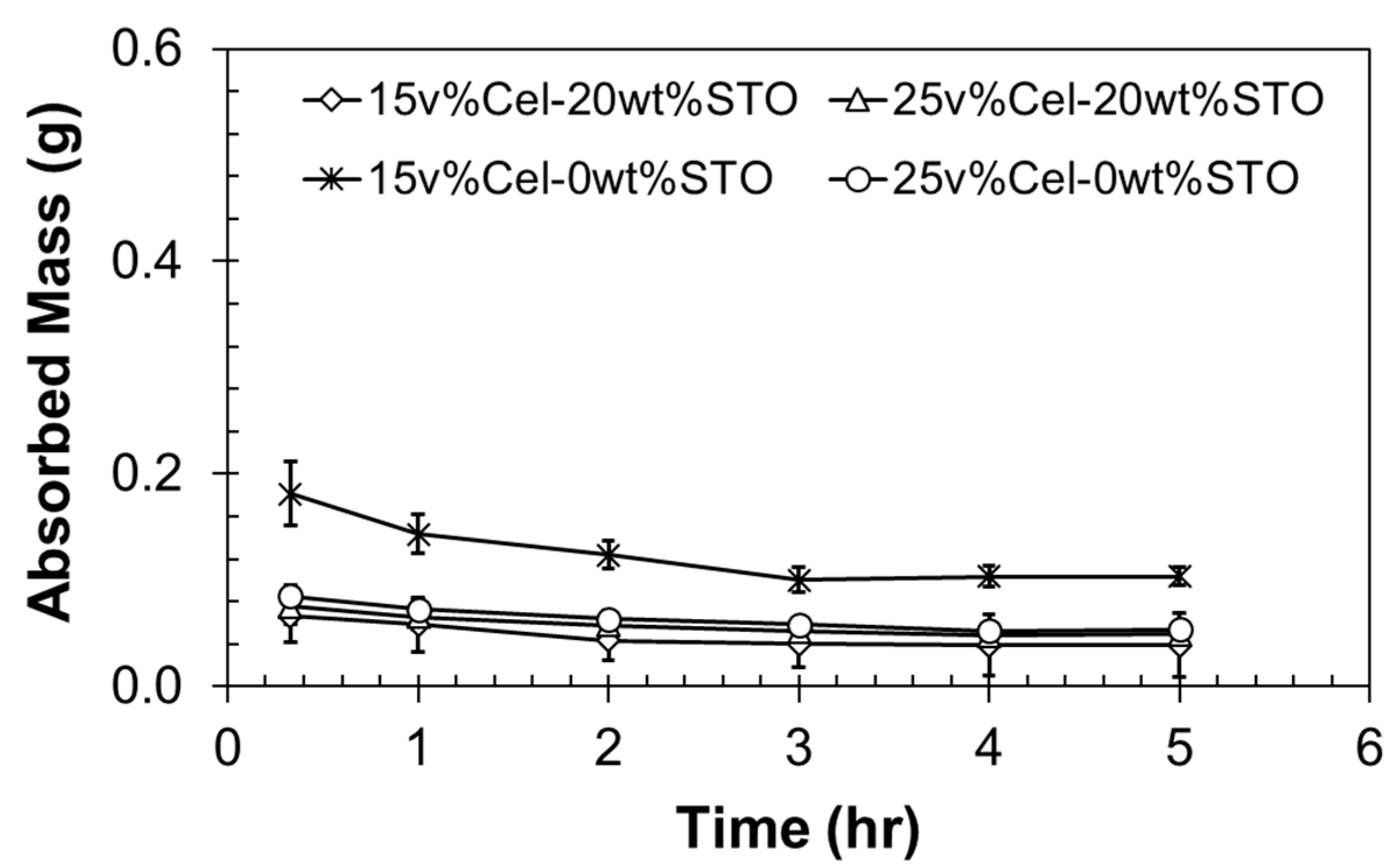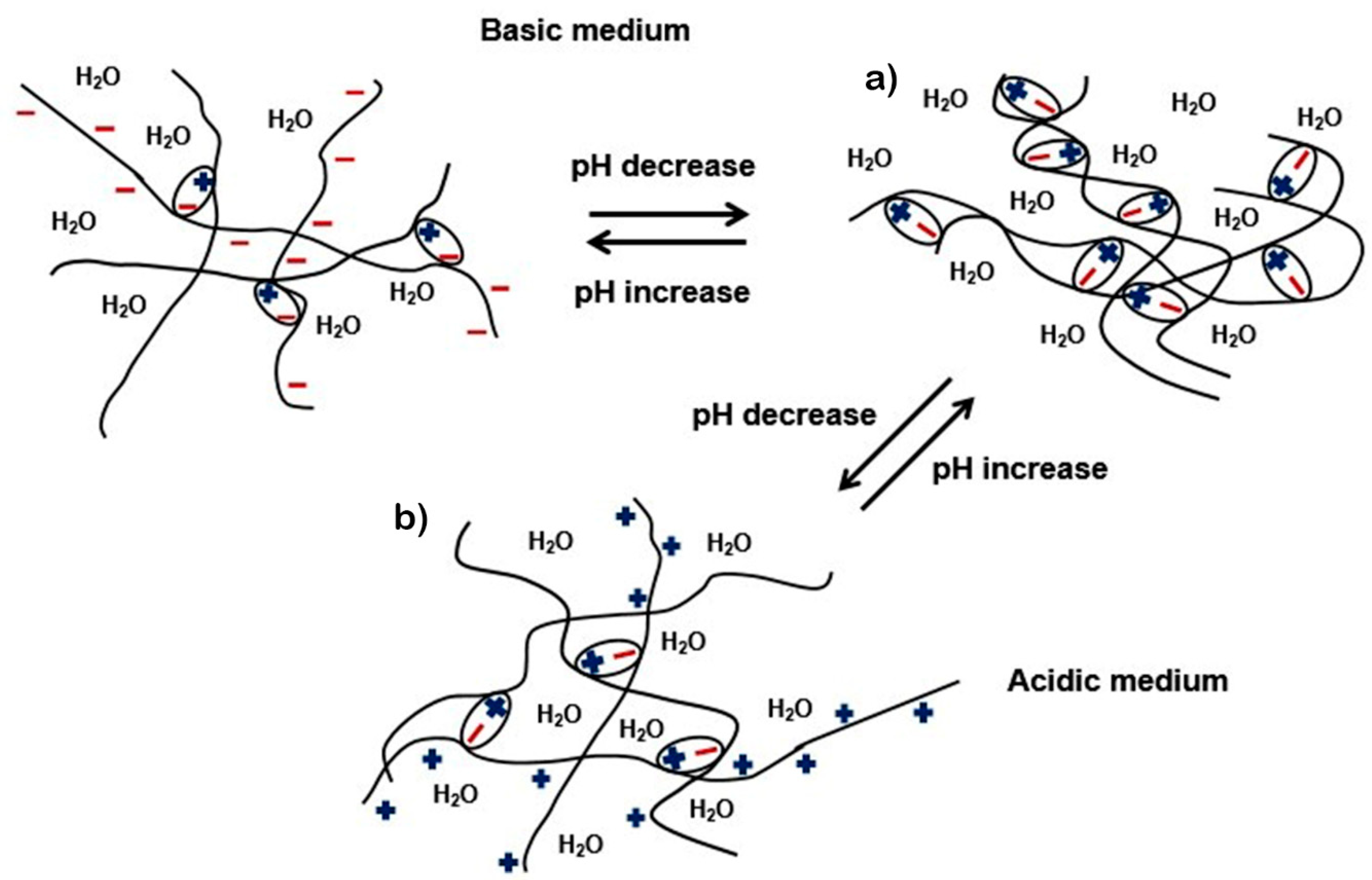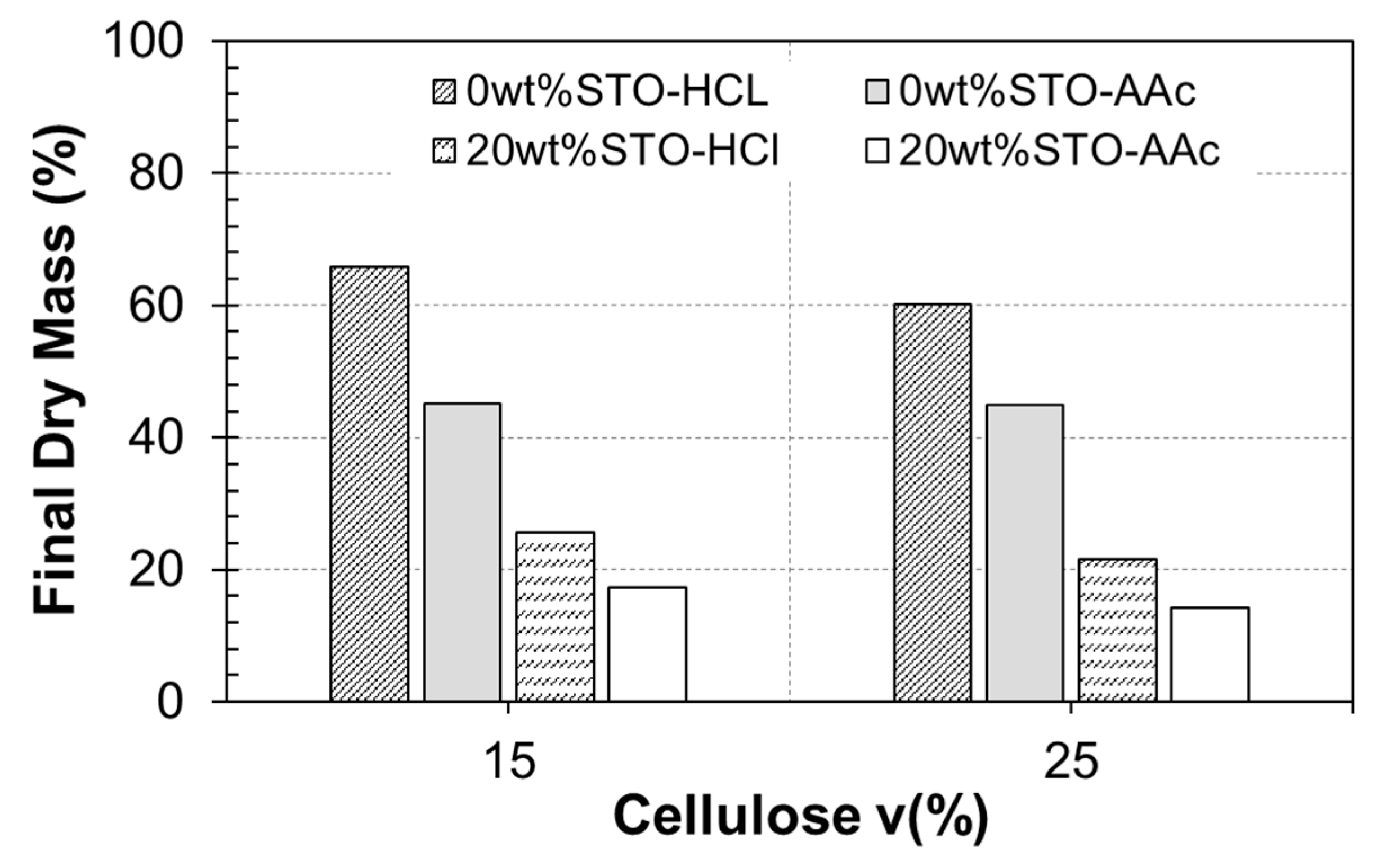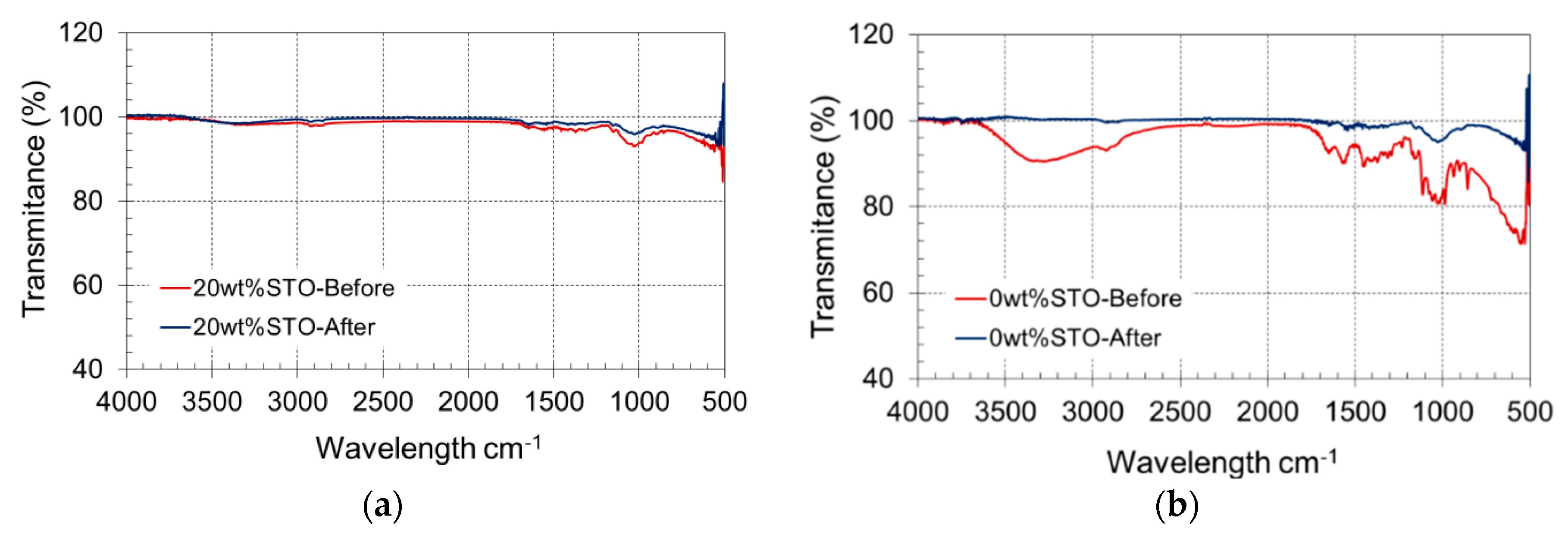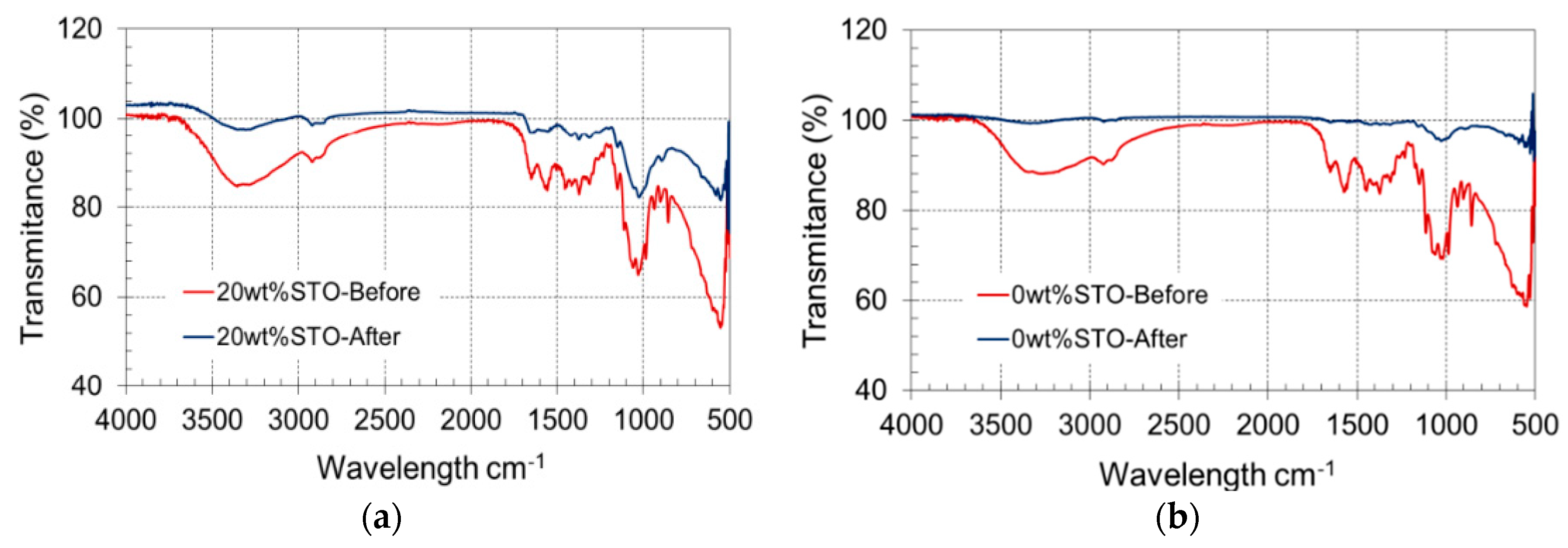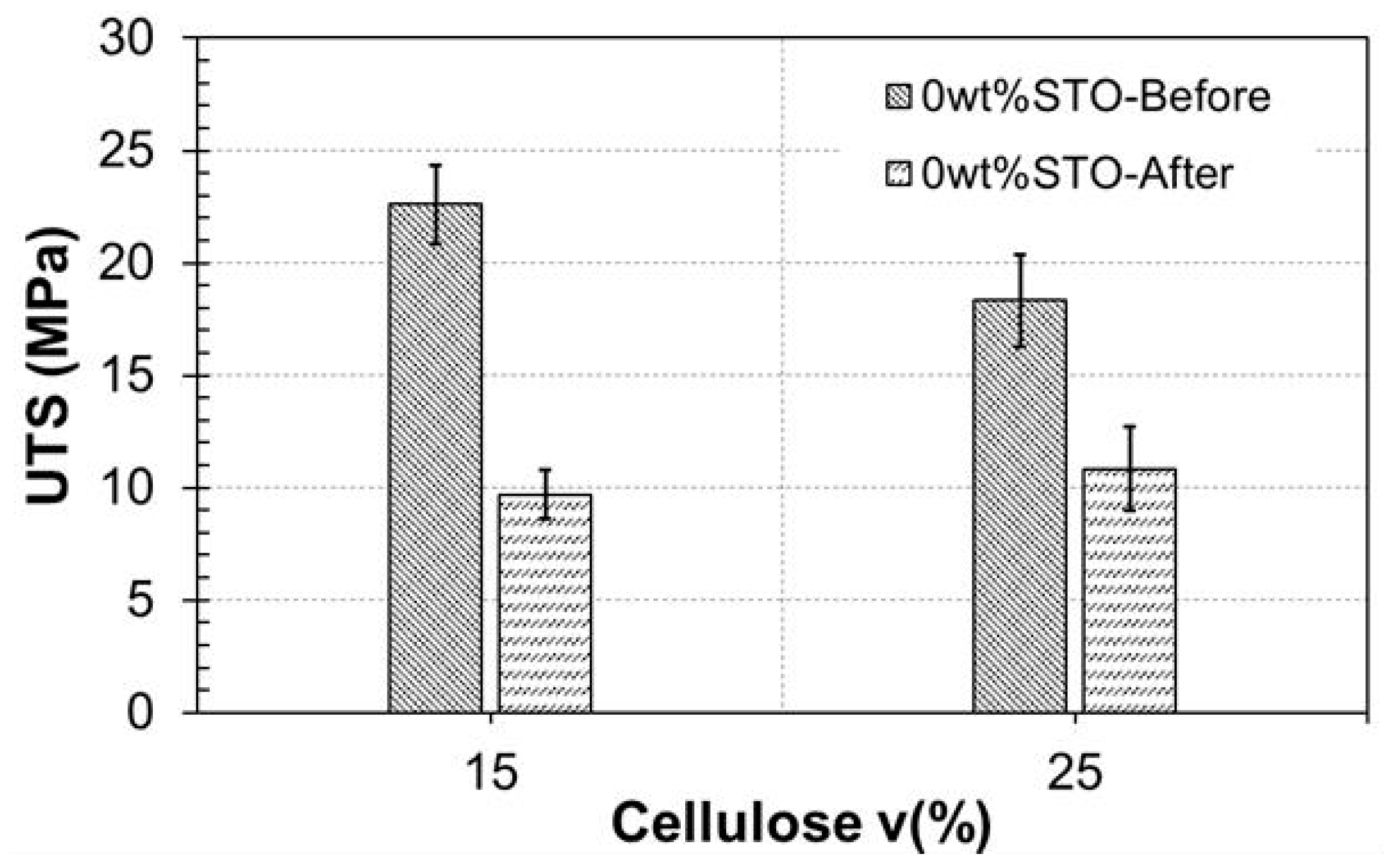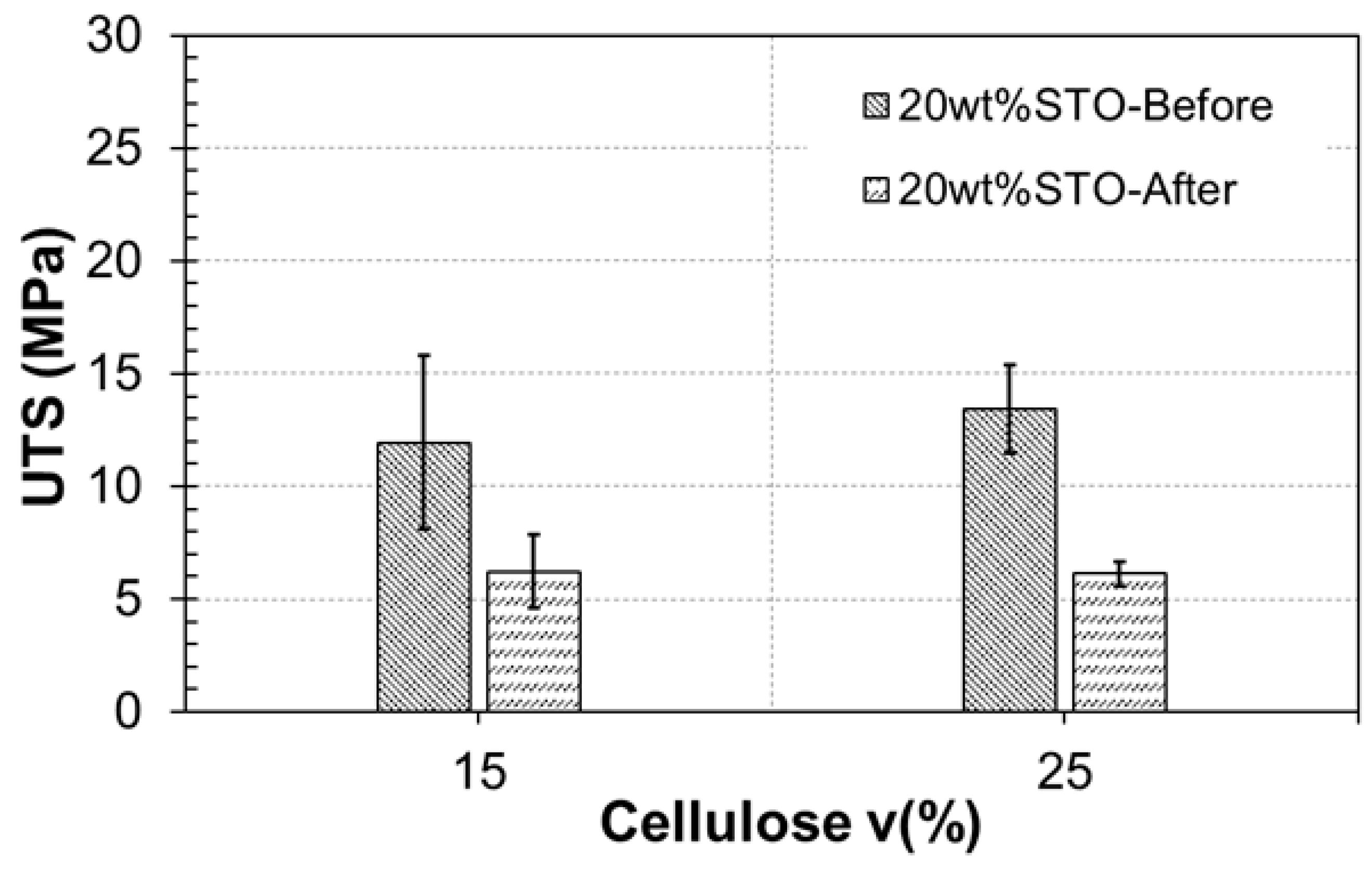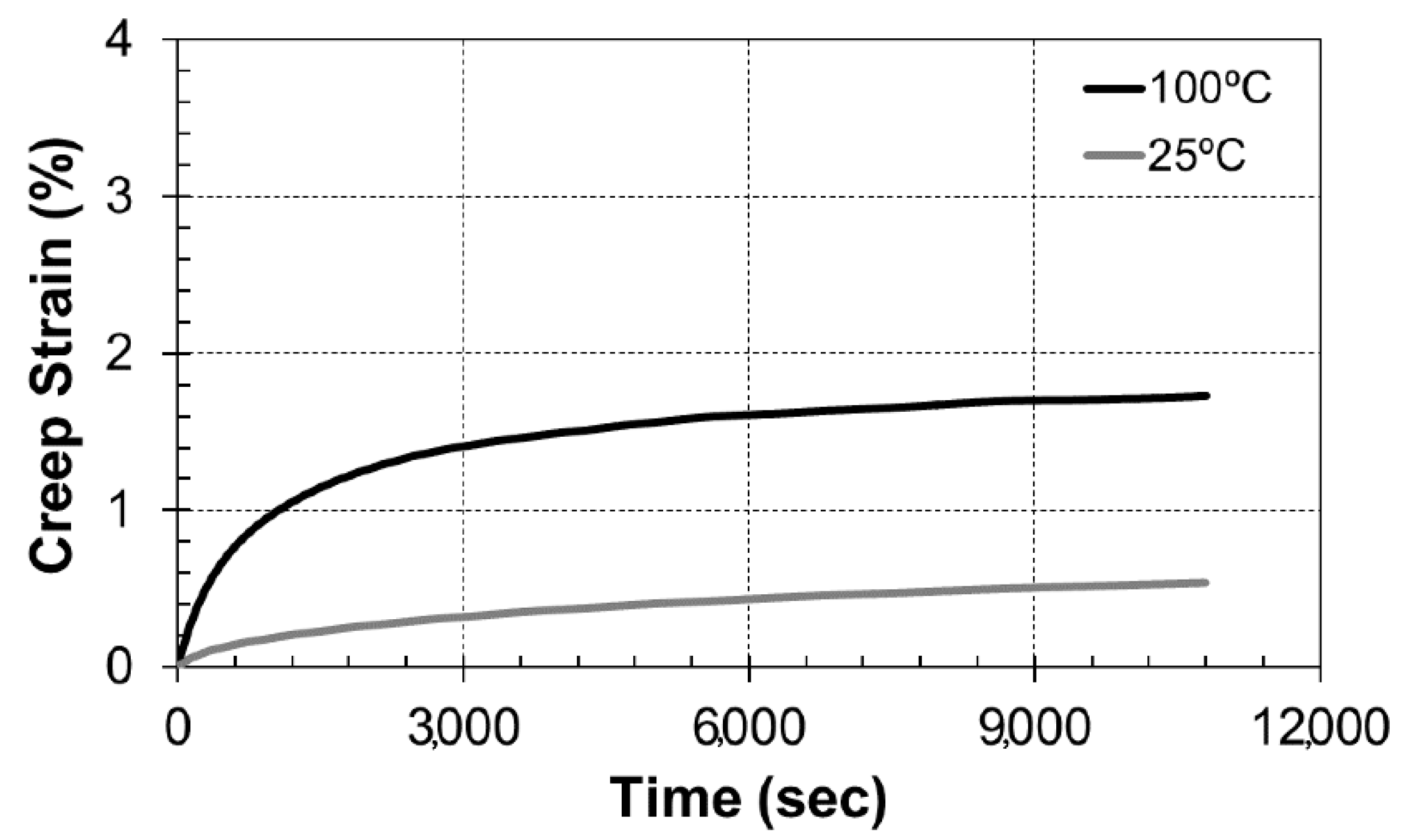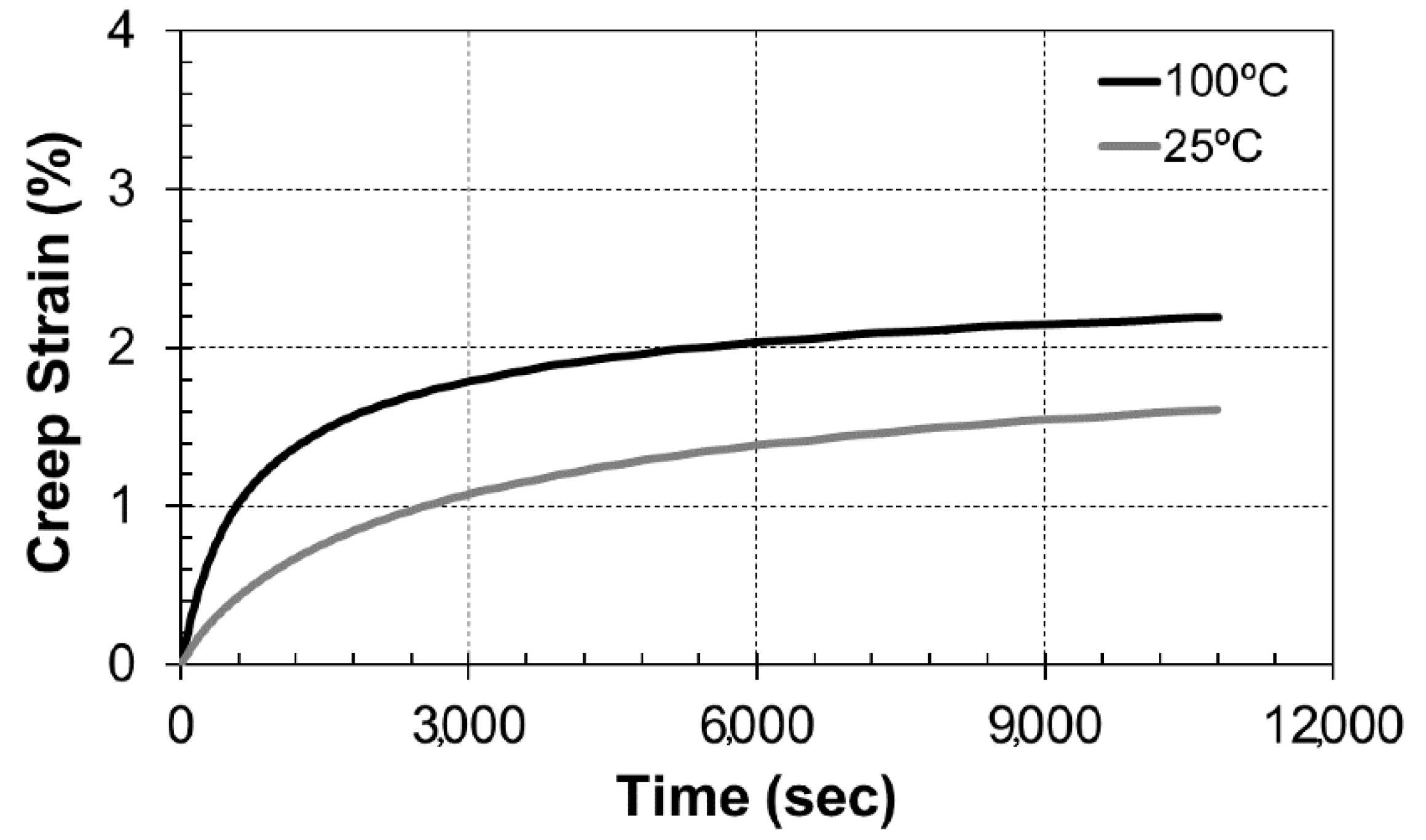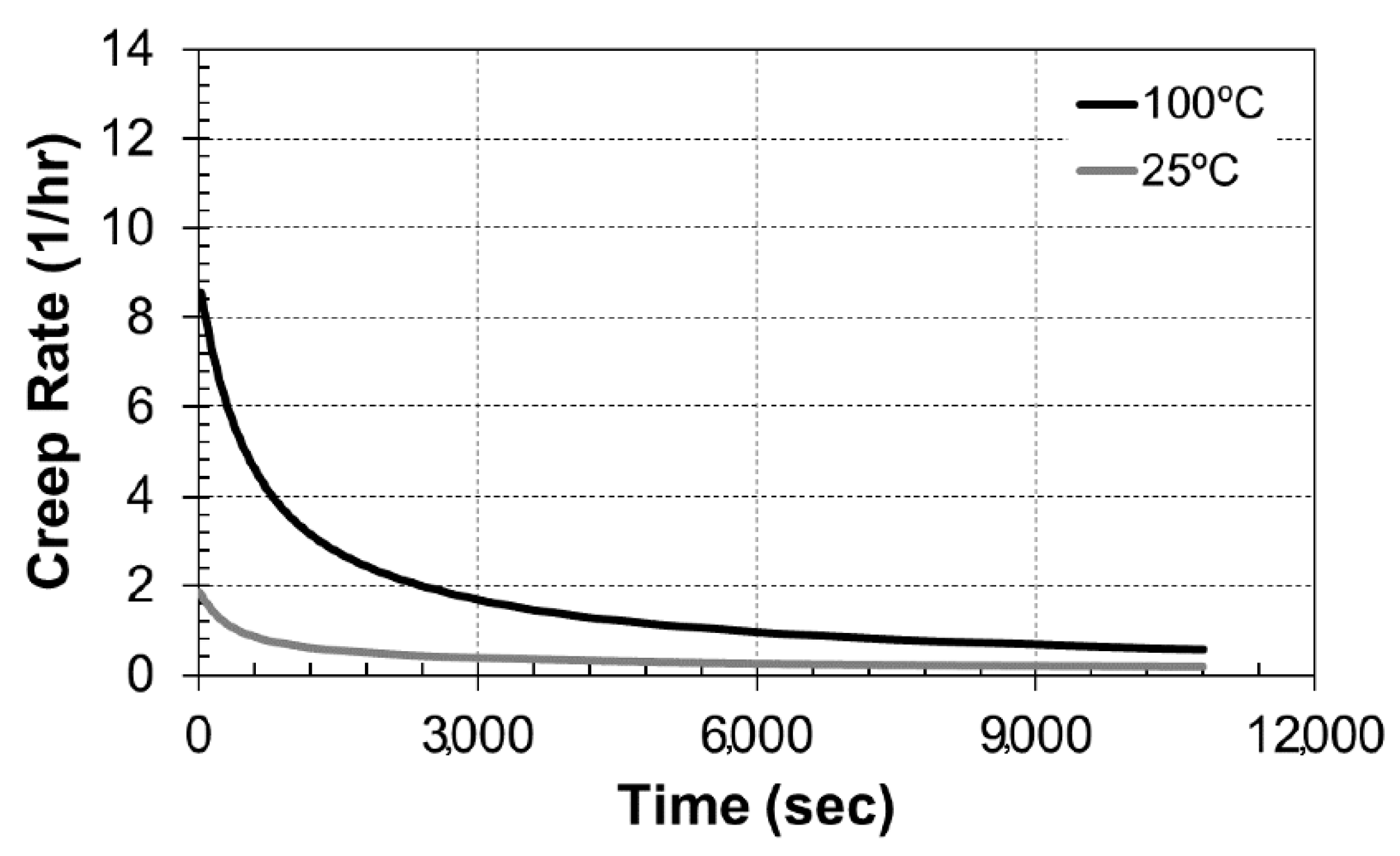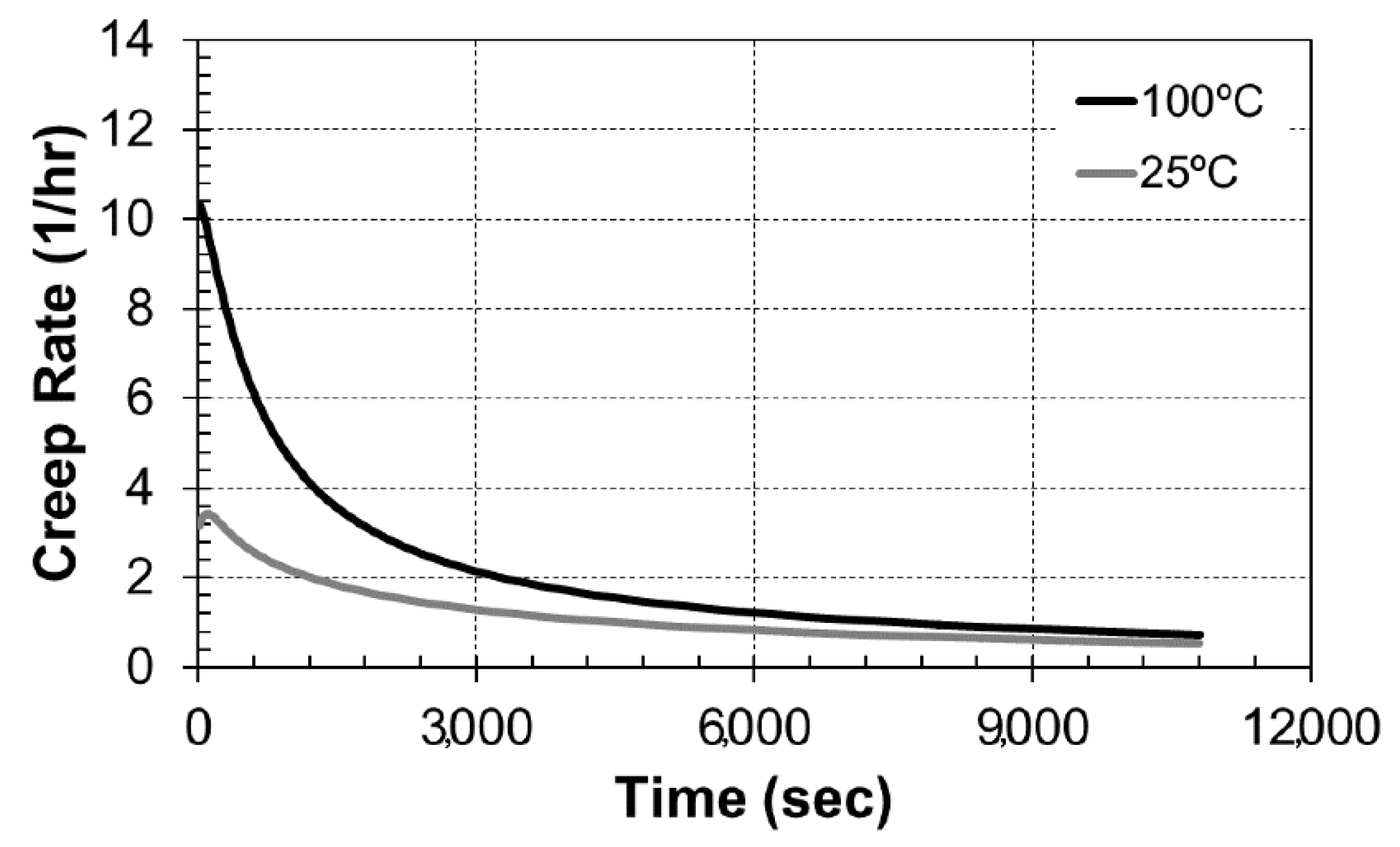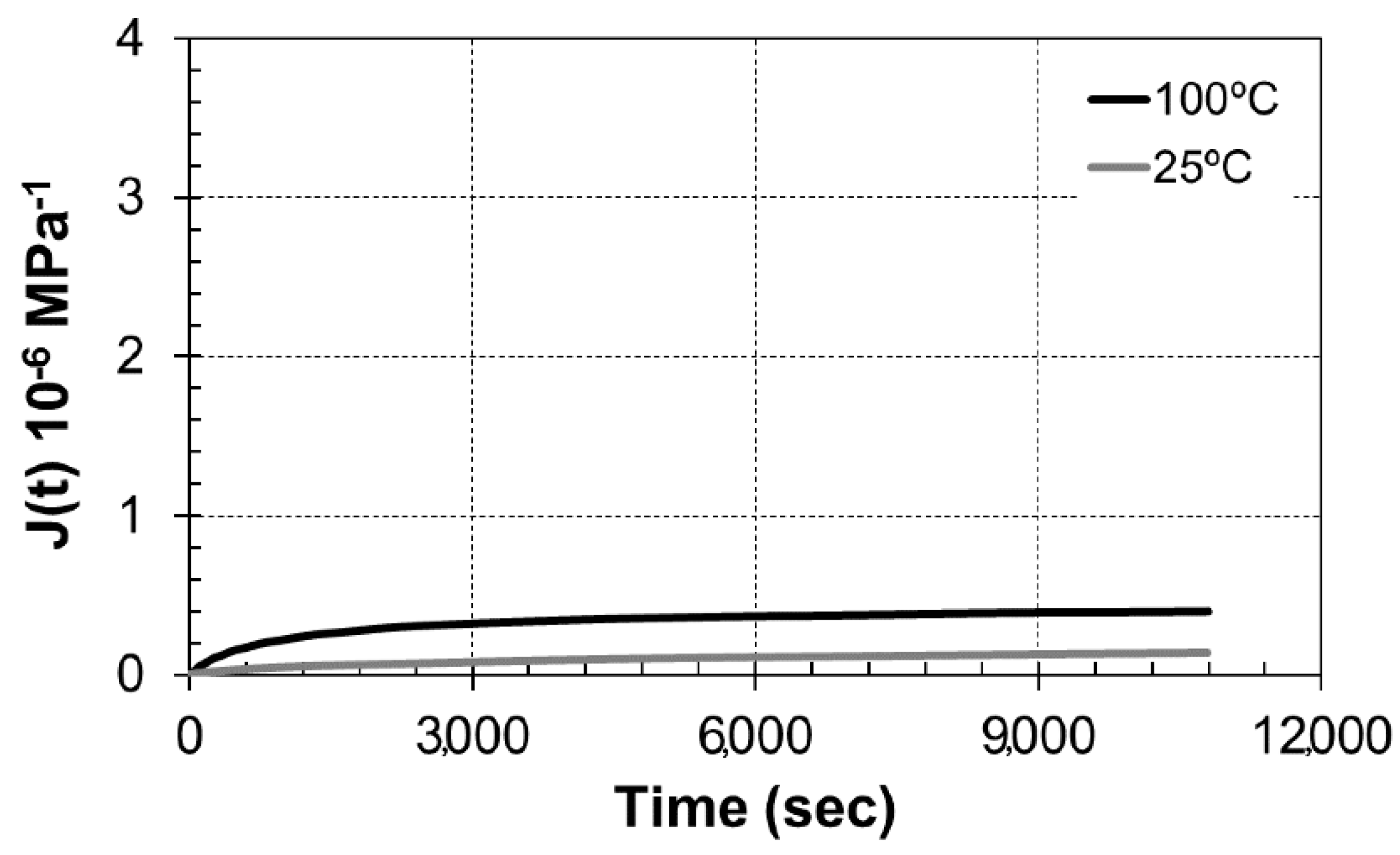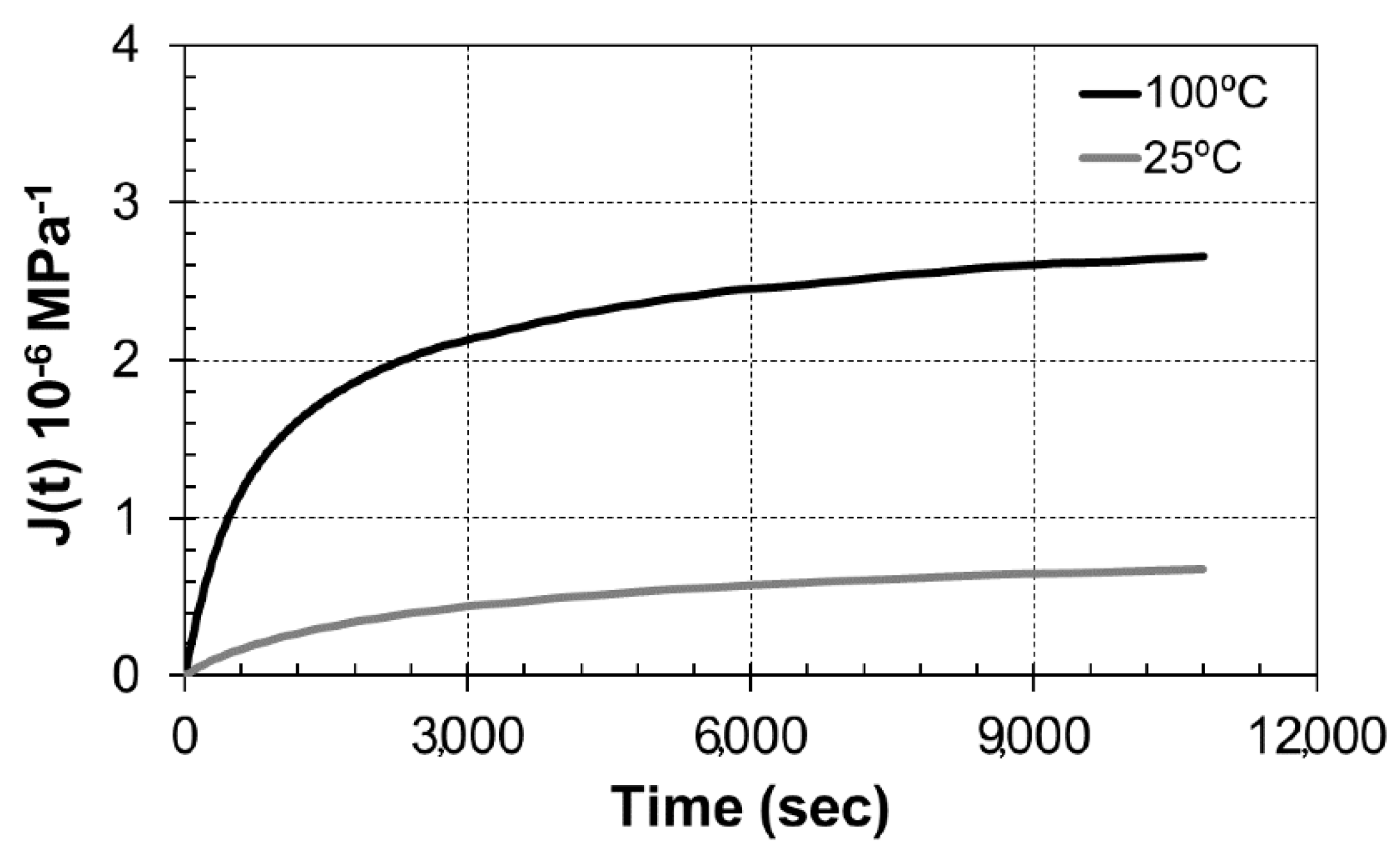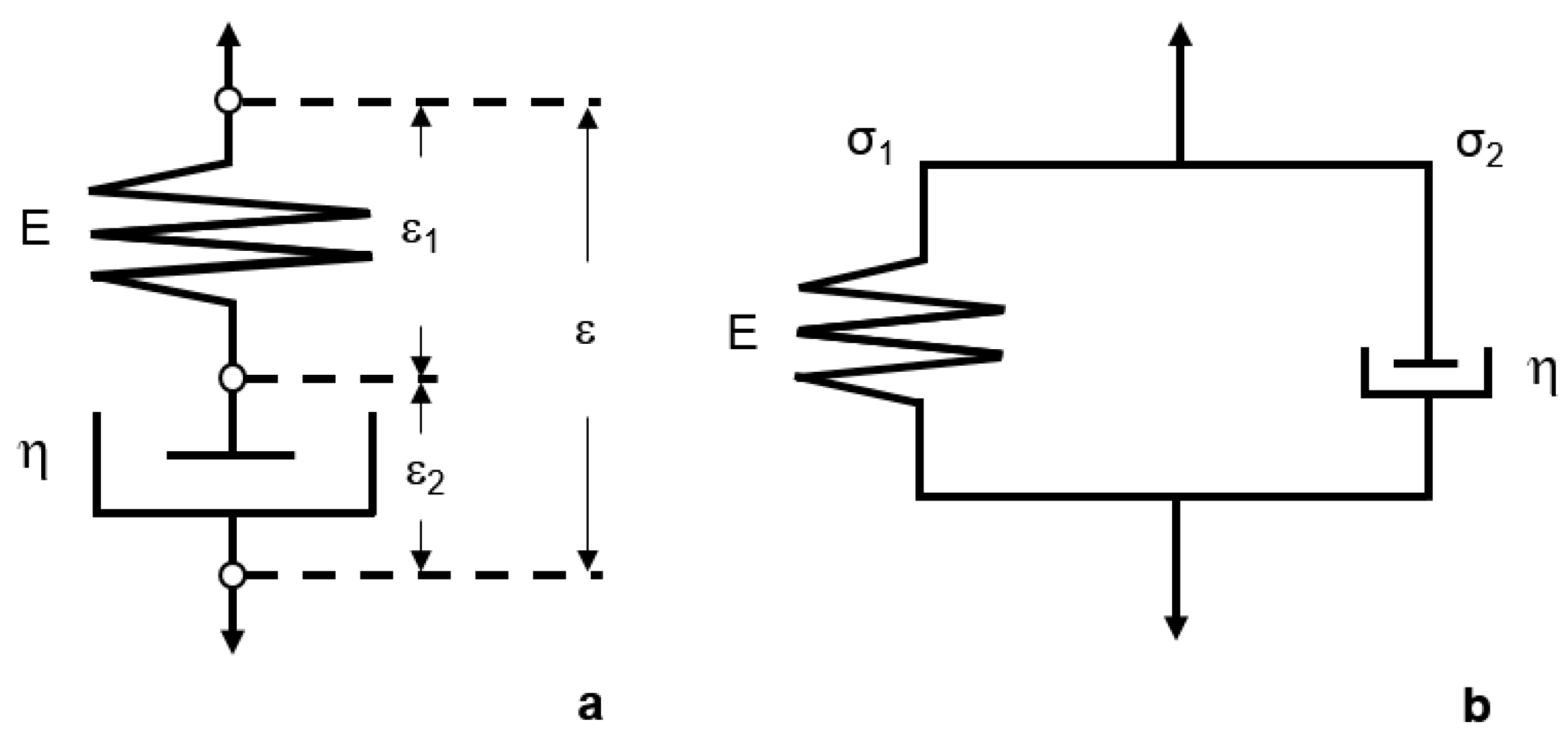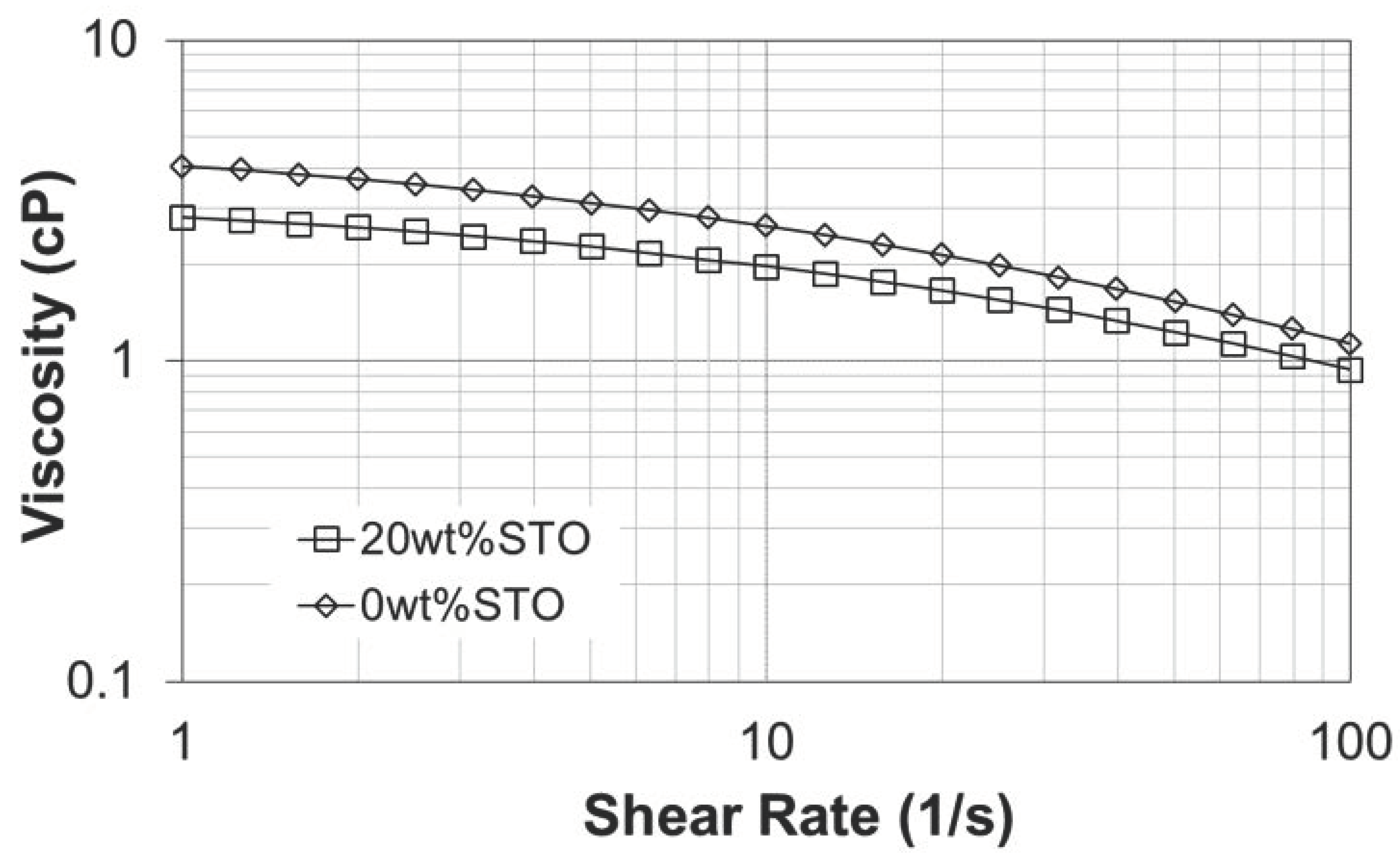3.1. Thermogravimetric Analysis
Figure 1 suggests that higher cellulose concentrations lowered the degradation temperature of the bio-composites made of chitosan and cellulose. This detrimental effect on the T
deg is due to the water content, which depends on the chitosan dissolution in the water/acetic acid medium and the addition of cellulose. Cellulose possesses three hydroxyl groups, which interact with the water molecules. This interaction raises the water content in the polymeric matrix by two possible means: (a) bonding of water molecules to the (–OH) groups; or (b) confinement of water molecules between the polymer chains due to intermolecular hydrogen bonds [
10,
11]. To remove the water retained in the polymer films, higher temperatures are required in the drying process. However, one must keep in mind that the drying process (higher temperatures) can damage the chemical structure of the polymer chains.
After studying the effects of the cellulose concentration, we analyzed the acetic acid concentration because previous findings reported that higher concentrations of acetic acid increased the water content in the polymeric films, which is required for the chitosan dissolution [
3,
12]. For that reason, we evaluated two acetic acid concentrations: 1.25 v% and 2.50 v%. The results indicate that cellulose lowered the degradation temperature of the bio-composites when more acetic acid was used in the synthesis. When we compared the acid concentration effect to each other, we observed lower T
deg for higher concentrations, according to
Figure 2. One must recall that, as the water content increased, the swelling degree of the composites also increased, following Hosokawa et al. [
3].
The swelling degree of the composites is directly affected by the crosslinking between chitosan and cellulose, which originates from the Schiff base reaction [
3,
12]. In the said base reaction, the hydrogen ions of the primary amino groups chitosan (–NH
2) interact with the aldehyde groups (–COH) of the cellulose leading the formation of (–CH=N–) groups at a pH of 6.0 [
3,
12,
13]. In other words, at this pH level, partial deprotonation of the anime groups occurs. When the pH falls below 6, the anime groups (–NH
2) exist in the protonated form (NH
+); increasing the electrostatic repulsion between the polymer chains. Higher electrostatic repulsions allow the entry of more water molecules between polymer chains. Thus, the swelling degree increases, resulting in a lower cross-linking degree of the polymer chains.
Even though the addition of STO nanoparticles slightly increased the composites T
deg, larger amounts of nanoparticles lowered considerably that T
deg, when one compares the 0 wt. % and 20 wt. % samples. For low nanoparticle amounts, the interfacial polymer-nanoparticles adhesion dominates [
6,
14]. Furthermore, the nanoparticles agglomerates can affect the composites T
deg by cutting down the interaction between the nanoparticles and the polymer matrix. Additionally, the nanoparticles could have increased the porosity in the polymeric matrix, eventually affecting the bulk mechanical properties [
14].
3.3. Degradation Analysis
As an ancillary investigation, the composites underwent a simplified degradation protocol in three media: a strongly acidic HCl solution, a less acidic CH3COOH one, and deionized water. To this purpose, we prepare the media with the acids and deionized water to attain a given pH in Petri dishes: hydrochloric acid (pH 3.3), acetic acid (pH 4.1), and water (pH 6.5). The pH value of the deionized water is not 7.0 due to the removal of minerals. Then, we submerged the composites in the corresponding media for a given time, which was recorded to assess the progression of the material weight loss.
Figure 5,
Figure 6 and
Figure 7 present the absorbed mass of the polymer-STO composites as a function of time in hydrochloric acid, acetic acid, and water, respectively. The combined addition of cellulose and nanoparticles delayed the degradation of the polymeric films, which is also affected by the solution utilized. For hydrochloric acid, the absorbed mass ranged from 0.02 g to 0.45 g while for acetic acid this falls between 0.02 g and 0.23 g, and for water, 0.04 g to 0.18 g. These figures also revealed an exciting behavior: after we placed the composite in the solution, the absorbed mass increased rapidly for 0.33 h. After this time, the absorbed mass lowered to eventually increase for times longer than 2 h. The bio-composites degraded fast in hydrochloric acid solution compared to acetic acid solution and, naturally, water.
Naturally, HCl is considered a strong acid compared to CH
3COOH. Stronger acids dissociate entirely into its ions as the weak acids partially do the same. Thus, the complete dissociation of the strong acids increased the protonation of the amine groups of the chitosan. As stated before, at pH values below 6.0, the amine groups (–NH
2) are protonated, forming (NH
+) groups [
3,
12,
13]. These groups raise the negative charges, increasing the electrostatic repulsion between the polymer chains and more water molecules relocate between the chains.
Figure 8 provides a schematic of this mechanism.
Also, the reaction reached the maximum protonation at 0.33 h, eventually decreasing due to pH changes from acid level to basic level. As a result, the swelling of the bio-composites decreased. This reversible reaction is dramatically affected by the pH of the solution.
Figure 9 provides the dry mass percent after degradation. As expected, the addition of cellulose and STO nanoparticles lowered the composites T
deg. When the effects of HCl and CH
3COOH were compared, our results indicated, as expected, that the polymer degraded faster in the stronger acid.
Subsequently, the dissolution rate constant (k
dis) was obtained using Equation (1) and shown in
Figure 10 [
16].
In Equation (1), Mpt and Mp0 are defined as the dry mass at time t and time t = 0, respectively, while At represents the surface area of the specimen at time t. Clearly, kdis decreased at higher amounts of cellulose and STO nanoparticles. In addition, as mentioned earlier, HCl caused the nanocomposites to degrade faster.
Figure 11 and
Figure 12 show the FTIR spectra of bio-composites made of 25 v% of cellulose degraded in HCl and CH
3COOH solutions. The spectrum reveals a band at 3400 cm
−1 characteristics of (–OH) groups, two bands at 1650 cm
−1 and 1560 cm
−1, which represent the amide I and (–NH
2), respectively [
12]. Moreover, the spectra show a band near 1733 cm
−1 characteristic of (–CHO), which corresponds to cellulose [
12].
As stated by Davidson, polymer degradation can be evaluated using FTIR [
17]. The spectra would show real bands and negative bands. Additionally, the bands can change their shape and position. Our FTIR analysis demonstrated the degradation effects on the bio-composites after exposure to NaCl and CH
3COOH (
Figure 11 and
Figure 12).
In the degraded polymers, the characteristic bands of chitosan and cellulose disappeared. However, the spectrum reveals a band near 1072 cm−1, which is characteristic of (C–O) groups, present in the chitosan and cellulose structures. Furthermore, the results suggest that the STO nanoparticles presence reduced the degradation of the bio-composites, which agrees with the results presented in a prior section.
The next step to complete a degradation study was to assess the UTS of our bio-composites after degradation in the stronger acidic solution: the HCl solution. As mentioned previously, we observed higher degradation in bio-composites submerged in the HCl solution than in the acetic acid one. As expected,
Figure 13 and
Figure 14 reveal how tensile strength diminished after degradation at two different composite loadings (amount of reinforcement). The results are as expected since as polymers degrade, loss of mass and scission of chains affects the mechanical strength of the material. The stability of the material is further compromised when a load is applied.
3.4. Creep Behavior Analysis
The creep study took place at two temperatures, i.e., 25 °C and 100 °C, under a constant applied load of 1.0 N. Before discussing in detail, the creep deformation, we deem important to report that the obtained glass transition temperature (Tg) of the composites ranged between 210 °C to 220 °C. Hence, we decided to conduct our creep analysis below the Tg of the composites to simulate better operation conditions of devices made with these biopolymer composites. In other words, we did not reach the highest possible deformation of the composites.
The measured creep strain as a function of time at 25 °C and 100 °C are presented in
Figure 15 and
Figure 16 for the matrix and a composite containing 20 wt. % STO nanoparticles. For the sake of brevity, we limited the analysis of the creep behavior of these composites to the instantaneous deformation, primary stage, and an incomplete secondary stage (when the strain rate kept constant). We could not reach the tertiary stage as the time required exceeded the one allotted to this research. Nonetheless, our results revealed clearly that the overall strain of the polymer/STO nanoparticles composites was higher than the chitosan-cellulose ones (no STO particles). We attributed such unexpected behavior to the viscosity of the solution upon fabrication of the composites. High viscosity in polymers delays the creep strain by hampering the mobility of the polymer chains. Additionally, and as expected, the creep strain rose with temperature.
Contrary to previous findings, the composites containing STO nanoparticles yielded higher creep deformation, which we attributed to several factors. Chitosan (present in larger amounts than cellulose in the polymeric matrix) possesses higher stiffness and resistance to deformation that lowered the creep deformation of our composites. When nanoparticles are present in the polymeric matrix, one must consider several factors affecting the creep deformation. In effect, as stated by Yang et al., creep deformation is altered by amorphous regions and crystallized chains, the/polymeric matrix/nanoparticles interface, bridging segments between nanoparticles, and even dangling polymeric ends [
7].
As mentioned, the amorphous and crystalline regions could influence the creep behavior of our composites. In our case, the composite matrix was made of semi-crystalline polymers. When a load is applied to the crystalline chains, they rapidly respond to the mechanical stress and transfer the applied loads. However, the amorphous regions act as dumping sites to create a Voigt’s or Zener’s viscoelastic behavior [
18,
19,
20]. Henceforth, a time slag allows withstanding the load as the chains are less oriented throughout the bulk polymer. Even if the polymer has high crystalline regions, the creep deformation is, therefore, slowed down.
When reinforcing particles are added to the polymeric matrix, they could alter the local crystallinity of the material, as indicated by Yang et al. [
7]. However, in our case, we proved that the addition of the particles did not affect the crystallinity of the polymeric matrix. At the beginning of this section, we indicated that our test temperature never exceeded the Tg. This was not modified with the addition of the nanoparticles, as the Tg values fell between 210° to 220° for all these composites.
Furthermore, at this point, one must indicate that despite our careful attempts, some reinforcing strontium titanate nanoparticles agglomerated likely due to the electrostatic forces among them. As the polymer/STO interface is relevant to the creep strain response, the agglomerates could have slipped at higher shear stresses. This could lead to crack nucleation nigh the agglomerates. Thus, under the applied load of 1 N, the crack propagation likely continued through the polymeric matrix as a slow velocity deformation took place.
3.4.1. Creep Rate
Naturally, the dimensional stability of the nanocomposites was determined by the creep rate, i.e., the velocity of the creep strain provided by the TMA. According to
Figure 17 and
Figure 18, a higher creep rate is apparent in composites reinforced with 20 wt. % STO nanoparticles. Additionally, and as expected, higher temperatures increased the creep rate of our composites. Further, those figures show how the creep rate decreased and led a constant creep rate (secondary creep stage). The steep reduction in creep rate could be due to the hardening caused by the orientation of the polymer chains under stress [
19]. After 1.5 h (i.e., onset of the secondary creep stage), the polymer chains reached a dynamic equilibrium.
3.4.2. Creep Compliance
The TMA unit, operated at 25 °C and 100 °C (below Tg) and applying a 1.0 N constant load, allowed acquiring the creep compliance curves as a function of time, shown in
Figure 19 and
Figure 20. Clearly, the graphs showed that, as expected, at higher temperatures, when the mobility of the polymer chains increases, the creep deformation of the composites is also higher.
3.4.3. Creep Compliance: Burger Model
It is well known that viscoelastic behavior upon creep is modeled using springs and dashpot arranged in series or parallel to formulate different models. Relevant in biopolymeric applications, the Maxwell model consists of springs and dashpots connected in series [
21], while the Kelvin–Voigt model a parallel arrangement of spring and dashpots [
22], as shown in
Figure 21. In our creep compliance analysis, we utilized the Burger’s model, which combines both according to Equation (2) [
23].
In Equation (2), ε represents the true strain, while σ is the true stress; E
1 represents the elastic recovery and E
2, the rubbery elasticity of the bio-composites. Also, η is the coefficient of viscosity of the bio-composites. The shear creep compliance J(t), which is important in polymers, is defined as the change in strain as a function of time under constant stress and is modeled following Equation (3) [
23].
In Equation (2), ε is the strain as a function of time and
, the constant applied stress. One can then modify Equation (3) with Equation (2) to obtain Equation (4).
The coefficients E
1, E
2, η
1, and η
2 in the Burger’s model allowed analyzing the viscoelastic behavior of the composites; they are shown in
Table 1. At 100 °C, E
1 for 0 wt. % STO nanoparticles were higher than for 20 wt. % STO nanoparticles, indicating that the instantaneous deformation was lower for the bio-composites without nanoparticles. In other words, the polymer-STO nanoparticles composites suffered more deformation under an applied load and temperature. Similarly, the E
2 value for 0 wt. % STO nanoparticles presented higher creep deformation than those from the bio-composites bearing titanate nanoparticles with a higher permanent deformation. Conversely, the coefficients of viscosity (η
1 and η
2) were lower for the composites with STO nanoparticles, leading to more permanent creep strain. When η
1 and η
2 were compared, one observed that the coefficients of viscosity for the bio-composites containing 20 wt. % STO nanoparticles were lower than for the material without nanoparticles. This suggests that the viscous flow of the polymer chains is higher at 20 wt. % STO nanoparticles. When no STO nanoparticles are present, there is a reduction in the mobility of the polymer chains due to the higher viscosity. This result compelled us to analyze the viscosity of the solution.
To assess the viscosity effects on the creep deformation of the composites, we analyzed the viscosity of the solutions containing 20 wt. % STO and without STO. The results from
Figure 22 suggest that the bio-composites containing 20 wt. % STO nanoparticles displayed less viscosity than those with 0 wt. % STO nanoparticles.
Recent studies demonstrated how the addition of nanoparticles could decrease the viscosity of a polymer solution. Tuteja et al. stated that the viscosity of the solution could be affected by the entanglement of the polymer chains, the interparticle half-gap and the morphology of the nanoparticles [
24,
25]. As the polymer chains are entangled, the available free volume increases reducing the viscosity of the composite. Similarly, the interparticle half-gap (h) and the radius of gyration (R
g) plays an essential role in the viscosity effect. When h is less than R
g, the viscosity values were lower due to the diffusion of the nanoparticles, which are larger than the polymer chains. Thus, the nanoparticles do not participate in the entanglement of the polymer chains; decreasing the viscosity of the solution. Additionally, only spherical particles (like the ones used in this research) can decrease the viscosity compared to other materials like nanoclays and carbon nanotubes due to their morphology [
25].
As stated initially, we also studied the creep strain at 25 °C. At this temperature, the Burger’s model cannot predict the creep behavior of the composites. Contrary to the viscoelastic behavior observed at higher temperatures (with polymer chains mobility is affected by temperature), at 25 °C the elastic behavior is more explicit (dominant) than the viscous one.
Previous studies explored the diverse electrical characteristics of capacitors made using the bio-composite studied in this project to compare those capacitors with commercial ones [
8,
9]. Those findings proved that these types of bio-composites are suitable for a range of electronic devices. The present research expands those prior investigations by providing a comprehensive study of their mechanical and thermal properties of composite material. Furthermore, it addresses a critical query for electronic devices: their ability to handle mechanical stresses as well as high temperatures and aggressive corrosive environments. One must note that previously we found that higher levels of cellulose raised the water content, which is detrimental to the current density in the devices. In this present research, we furthered the study of these bio-composites to provide a better understanding of their mechanical and thermal properties. We are confident that the present detailed research combined with the wealth of information on ferroelectric bio-composites will lay the foundation for future research that uses this material to fabricate novel electronic devices [
25,
26].
